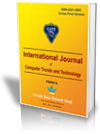Code Detection and Evaluation Using Search Based Refactoring

Gousiya Begum, S. Amalan S A, GeethaDevasena M S "Code Detection and Evaluation Using Search Based Refactoring"International Journal of Computer Trends and Technology (IJCTT),V4(4):796-799 April Issue 2013 .ISSN 2231-2803.www.ijcttjournal.org. Published by Seventh Sense Research Group.
Abstract: -Software testing is a critical element of software quality assurance that represents the ultimate review of specifications, design and coding. In computer programming, code smell is the symptom in the source code of a program indicating a deeper problem. Code smells are usually not bugs, they are not technically incorrect and don`t currently prevent the program from functioning. Instead, they indicate weaknesses in design that may be slowing down development or increasing the risk of bugs or failures in the future. Code and design smells are poor solutions to recurring implementation and design problems. Bad smells are signs of potential problems in code. Detecting and resolving bad smells remain time-consuming for software engineers .Numerous bad smells have been recognized, the sequences in which the detection and resolution of different kinds of bad smells are performed rarely because software engineers do not know how to optimize sequences or determine the benefits of an optimal sequence. So, a new sequence for different kinds of bad smells has been implemented, to simplify the detection and resolution of bad smells based on refactoring method. This system reduces the code complexity occurred in coding environment and improves the quality of software.
References-
[1] Hui Liu and Weizhong Shao, “Schedule of Badsmell Detection and Resolution:A New Way to Save Effort,”IEEE Trans. Software Eng., vol. 38, no. 1 Jan/Feb. 2012.
[2] W.F. Opdyke, “Refactoring Object-Oriented Frameworks,” PhD dissertation, Univ. of Illinois at Urbana-Champaign, 1992.
[3] M. Fowler, K. Beck, J. Brant, W. Opdyke, and D. Roberts,Refactoring: Improving the Design of Existing Code.Addison WesleyProfessional, 1999.
[4] W.C. Wake,RefactoringWorkbook.Addison Wesley, Aug. 2003.
[5] http://wiki.java.net/bin/view/People/SmellsToRefactorings,2011.
[6] W.G. Griswold and D. Notkin, “Automated Assistance forProgram Restructuring,”ACM Trans. Software Eng. and Methodol-ogy,vol. 2, no. 3, pp. 228-269, July 1993.
[7] F. Tip, A. Kiezun, and D. Baeumer, “Refactoring for General-ization Using Type Constraints,” Proc. 18th Ann. Conf. Object-Oriented Programming Systems, Languages, and Applications,pp. 13-26, Oct. 2003.
[8] T. Mens, N.V. Eetvelde, and S. Demeyer, “FormalizingRefactorings with Graph Transformations,” J. Software Main-tenance and Evolution: Research and Practice, vol. 17, no. 4,pp. 247-276, 2005.
[9] R. Koschke, “Identifying and Removing Software Clones,”Soft-ware Evolution,T. Mens and S. Demeyer, eds., pp. 15-36, Springer,2008.
[10] T. Kamiya, S. Kusumoto, and K. Inoue, “CCFinder: A Multi-Linguistic Token Based Code Clone Detection System for LargeScale Source Code,” IEEE Trans. Software Eng., vol. 28, no. 7,pp. 654-670, July 2002.
Keywords — Scheme, bad smell, software refactoring, effort, detection, schedule.


